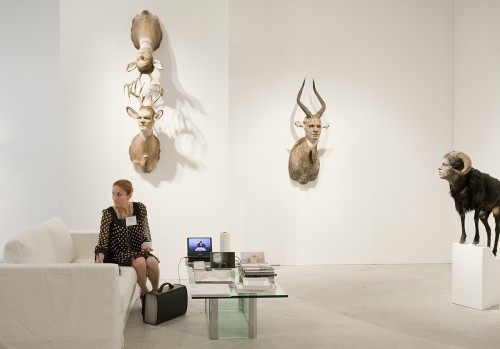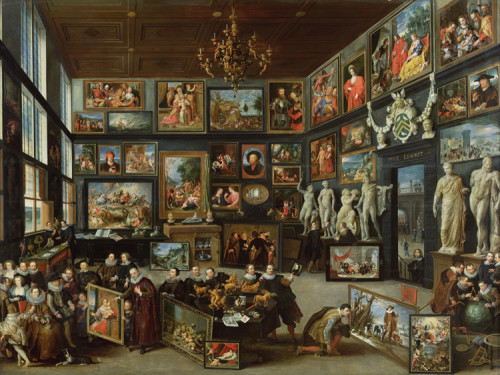
“How do I get represented in a gallery?” is one of the most common questions asked by artists. I asked nine artists who have regional and national representation to give me their elevator pitch. The results were interestingly similar: it’s something most artists have to continuously put effort into. There’s a nice reminder that not only is your studio practice important but an artist’s “office” has to be outside of the studio as much as inside the studio.
Drew Conrad (Get This Gallery in Atlanta and Fitzroy Gallery in New York City):
Obtaining gallery representation is not an easy task by any means, but I think a major component of making it happen is surrounding yourself with a supportive community of artists and colleagues. Both galleries that represent me came about because their gallery artists and other artists whose opinions they respect were talking about my work. That’s not to say I wasn’t showing up to every opening and supporting their program, but it is much easier to start talking about your own art practice and offering studio visits when the gallery is already familiar with what you do. Definitely take it slow, too. Get to know the gallery and let them get to know you. The relationship is a work in progress, and it will take time for the gallery to know if you are the right fit for its roster, or for you to decide if you even want to work with the gallery. Lastly, when it comes to studio visits, you usually only get one shot; make it count.
Carol Johns (Poem 88, Atlanta):
1)Make a lot of art. Keep making art. Make more art.
2)Have a lot of fun. Know your art community and enjoy it.
3)Cross your fingers, opportunities are out there, be ready for them.
Pam Longobardi (Tinney Contemporary, Nashville, and Sandler Hudson, Atlanta):
Do the legwork in advance of getting to know which gallery’s aesthetic and strategy your work fits into by visiting them over time to see a range of shows. Make sure your work is ready before you make the first move. And don’t expect things to happen over night, its the development of a relationship, so let them see your work over time.
Jiha Moon (Saltworks, Atlanta; the Curator’s Office, Washington, D.C.; Ryan Lee Gallery, New York City):
My advice for artists is to have a strong body of work and try to set up studio visits with gallerists and curators. I often hear about all these fairytales, like so-and-so is using fancy connections and recommendations. While I know that can be true, the artist’s work has to come first. I also realized that artists want to talk about their fabulousness and are often hiding all their hard work and dedication underneath it.

Amy Pleasant (Whitespace, Atlanta; Jeff Bailey Gallery, New York City):
1) The work has to be there first. So no matter what opportunity arises, you are ready. If you get the chance to share images or have a studio visit with someone, the work is waiting.
2) You have to put yourself out there in your community. So often your work is shared through another artist, curator, or interested collector/friend. These people want to help you and will spread the word, so stay connected and keep them informed.
3) Create opportunities to show your work in alternative spaces or open studios. Invite the people you are interested in having dialogue with into your studio. Create opportunities for discussion and feedback, and start the conversation.
If you have the work and you are engaging with the art community around you and beyond, your chance of getting to share it with dealers/galleries is much greater.
Shana Robbins (Beta Pictoris Gallery/ Maus Contemporary, Birmingham):
The answer for me is to immerse myself in the studio, apply for shows, invite critics, galleries, and curators to those shows, and then follow up on contacts that were made during that process. With my gallery, I had a show up at the Contemporary Art Center in Atlanta, and Guido Maus happened to go see it and loved the work. So, a lot of it is just making sure your work is seen—promotion and exposure. My sense of things in the “art world” now is that artists do not approach the galleries. It’s more like a mating call on the part of the artist—a display, a seduction—in which artists attempt to create something exquisite enough to attract a gallery’s attention, and thereby get them to want what you are making.
One additional piece of advice would be to talk about the latest project you have created—but no more than a few sentences. Otherwise, people lose interest.
Michael Scoggins (Saltworks, Atlanta; Freight + Volume, New York City):
A lot of research; cold calls don’t work. Know the gallery you’re approaching and make sure your work “fits.”
A lot of showing up to openings and various functions; it’s networking (and that doesn’t mean kissing ass). Get your name and face in front of gallery people. Be nice.
A lot of hard work. Get it done in the studio, make good stuff. That’s the most important part.
And a little bit of luck. Be ready to show at a moment’s notice and always have an exhibition’s worth of work available.
There really is not a correct answer. It depends on the individual. Sometimes you can do all the right things but not get any traction. Make art for yourself.
Whitney and Micah Stansell (Whitespace Gallery, Atlanta):
The most important thing is to work hard and make good work. Beyond that it is important to be a part of a community. Plan to go to shows with other artists and pay attention to the kind of work a gallery shows so that you can determine whether or not you work is a good fit. Don’t be afraid to introduce yourself!
Charmed, I'm Sure: How To Get Gallery Representation
Related Stories
Reviews
Reviews
Mood Ring
Orchid Daze by Lillian Blades at the Atlanta Botanical Gardens
Blake Belcher reviews Atlanta-based Bahamian artist Lillian Blades' new work engaging orchids, transplantation, and diaspora at the Atlanta Botanical Garden.
A Landscaped Longed For: The Garden as Disturbance at the Crisp-Ellert Art Museum, St. Augustine
Christopher Stephen reviews the visual metaphors of the garden found in A Landscape Longed For: The Garden as Disturbance at the Crisp-Ellert Art Museum, St. Augustine.
How To Get Free
Pieced together through collage, video capture, and a spoken poem, artist Kay-Ann Henry presents the intricacies of Afro-religious practices and Jamaica's particular expression of obeah, pocomania, and kumina.




